Inefficient degradation of truncated polyglutamine proteins by the proteasome
- PMID: 15470501
- PMCID: PMC524390
- DOI: 10.1038/sj.emboj.7600426
Inefficient degradation of truncated polyglutamine proteins by the proteasome
Abstract
Accumulation of mutant proteins into misfolded species and aggregates is characteristic for diverse neurodegenerative diseases including the polyglutamine diseases. While several studies have suggested that polyglutamine protein aggregates impair the ubiquitin-proteasome system, the molecular mechanisms underlying the interaction between polyglutamine proteins and the proteasome have remained elusive. In this study, we use fluorescence live-cell imaging to demonstrate that the proteasome is sequestered irreversibly within aggregates of overexpressed N-terminal mutant Huntingtin fragment or simple polyglutamine expansion proteins. Moreover, by direct targeting of polyglutamine proteins for proteasomal degradation, we observe incomplete degradation of these substrates both in vitro and in vivo. Thus, our data reveal that intrinsic properties of the polyglutamine proteins prevent their efficient degradation and clearance. Additionally, fluorescence resonance energy transfer is detected between the proteasome and aggregated polyglutamine proteins indicative of a close and stable interaction. We propose that polyglutamine-containing proteins are kinetically trapped within proteasomes, which could explain their deleterious effects on cellular function over time.
Figures
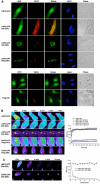
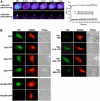
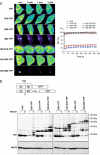

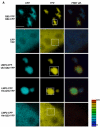
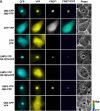
Similar articles
-
Intranuclear ataxin1 inclusions contain both fast- and slow-exchanging components.Nat Cell Biol. 2002 Oct;4(10):806-10. doi: 10.1038/ncb859. Nat Cell Biol. 2002. PMID: 12360291
-
Modulating huntingtin half-life alters polyglutamine-dependent aggregate formation and cell toxicity.J Neurochem. 2004 May;89(4):962-73. doi: 10.1111/j.1471-4159.2004.02376.x. J Neurochem. 2004. PMID: 15140195
-
Aggregate formation inhibits proteasomal degradation of polyglutamine proteins.Hum Mol Genet. 2002 Oct 15;11(22):2689-700. doi: 10.1093/hmg/11.22.2689. Hum Mol Genet. 2002. PMID: 12374759
-
Recent advances in understanding the pathogenesis of polyglutamine diseases: involvement of molecular chaperones and ubiquitin-proteasome pathway.J Chem Neuroanat. 2003 Oct;26(2):95-101. doi: 10.1016/s0891-0618(03)00029-2. J Chem Neuroanat. 2003. PMID: 14599658 Review.
-
Testing the possible inhibition of proteasome by direct interaction with ubiquitylated and aggregated huntingtin.Brain Res Bull. 2007 Apr 30;72(2-3):121-3. doi: 10.1016/j.brainresbull.2006.10.030. Epub 2006 Nov 20. Brain Res Bull. 2007. PMID: 17352935 Review.
Cited by
-
Visualizing Proteasome Activity and Intracellular Localization Using Fluorescent Proteins and Activity-Based Probes.Front Mol Biosci. 2019 Aug 20;6:56. doi: 10.3389/fmolb.2019.00056. eCollection 2019. Front Mol Biosci. 2019. PMID: 31482094 Free PMC article.
-
Pathogenic polyglutamine expansion length correlates with polarity of the flanking sequences.Mol Neurodegener. 2014 Nov 6;9:45. doi: 10.1186/1750-1326-9-45. Mol Neurodegener. 2014. PMID: 25377768 Free PMC article.
-
Modulation of polyglutamine conformations and dimer formation by the N-terminus of huntingtin.J Mol Biol. 2010 Mar 12;396(5):1295-309. doi: 10.1016/j.jmb.2009.12.017. Epub 2009 Dec 21. J Mol Biol. 2010. PMID: 20026071 Free PMC article.
-
Phosphorylation of NBR1 by GSK3 modulates protein aggregation.Autophagy. 2014 Jun;10(6):1036-53. doi: 10.4161/auto.28479. Autophagy. 2014. PMID: 24879152 Free PMC article.
-
Differential degradation of full-length and cleaved ataxin-7 fragments in a novel stable inducible SCA7 model.J Mol Neurosci. 2012 Jun;47(2):219-33. doi: 10.1007/s12031-012-9722-8. Epub 2012 Feb 25. J Mol Neurosci. 2012. PMID: 22367614 Free PMC article.
References
-
- Bence NF, Sampat RM, Kopito RR (2001) Impairment of the ubiquitin–proteasome system by protein aggregation. Science 292: 1552–1555 - PubMed
-
- Chen HK, Fernandez-Funez P, Acevedo SF, Lam YC, Kaytor MD, Fernandez MH, Aitken A, Skoulakis EM, Orr HT, Botas J, Zoghbi HY (2003) Interaction of Akt-phosphorylated ataxin-1 with 14-3-3 mediates neurodegeneration in spinocerebellar ataxia type 1. Cell 113: 457–468 - PubMed
Publication types
MeSH terms
Substances
Grants and funding
LinkOut - more resources
Full Text Sources
Other Literature Sources

